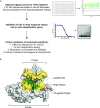Screening for E3-ubiquitin ligase inhibitors: challenges and opportunities
- PMID: 25237759
- PMCID: PMC4226663
- DOI: 10.18632/oncotarget.2431
Screening for E3-ubiquitin ligase inhibitors: challenges and opportunities
Abstract
The ubiquitin proteasome system (UPS) plays a role in the regulation of most cellular pathways, and its deregulation has been implicated in a wide range of human pathologies that include cancer, neurodegenerative and immunological disorders and viral infections. Targeting the UPS by small molecular regulators thus provides an opportunity for the development of therapeutics for the treatment of several diseases. The proteasome inhibitor Bortezomib was approved for treatment of hematologic malignancies by the FDA in 2003, becoming the first drug targeting the ubiquitin proteasome system in the clinic. Development of drugs targeting specific components of the ubiquitin proteasome system, however, has lagged behind, mainly due to the complexity of the ubiquitination reaction and its outcomes. However, significant advances have been made in recent years in understanding the molecular nature of the ubiquitination system and the vast variety of cellular signals that it produces. Additionally, improvement of screening methods, both in vitro and in silico, have led to the discovery of a number of compounds targeting components of the ubiquitin proteasome system, and some of these have now entered clinical trials. Here, we discuss the current state of drug discovery targeting E3 ligases and the opportunities and challenges that it provides.
Figures




References
-
- Melino G, Knight RA, Nicotera P. How many ways to die? How many different models of cell death? Cell death and differentiation. 2005;12(Suppl 2):1457–1462. - PubMed
-
- Muller M, Schleithoff ES, Stremmel W, Melino G, Krammer PH, Schilling T. One, two, three--p53, p63, p73 and chemosensitivity. Drug resistance updates : reviews and commentaries in antimicrobial and anticancer chemotherapy. 2006;9(6):288–306. - PubMed
-
- Ciechanover A. Intracellular protein degradation: from a vague idea thru the lysosome and the ubiquitin-proteasome system and onto human diseases and drug targeting. Cell death and differentiation. 2005;12(9):1178–1190. - PubMed
-
- Hershko A. The ubiquitin system for protein degradation and some of its roles in the control of the cell division cycle. Cell death and differentiation. 2005;12(9):1191–1197. - PubMed
-
- Rose I. Ubiquitin at Fox Chase. Cell death and differentiation. 2005;12(9):1198–1201. - PubMed
Publication types
MeSH terms
Substances
Grants and funding
LinkOut - more resources
Full Text Sources
Other Literature Sources

